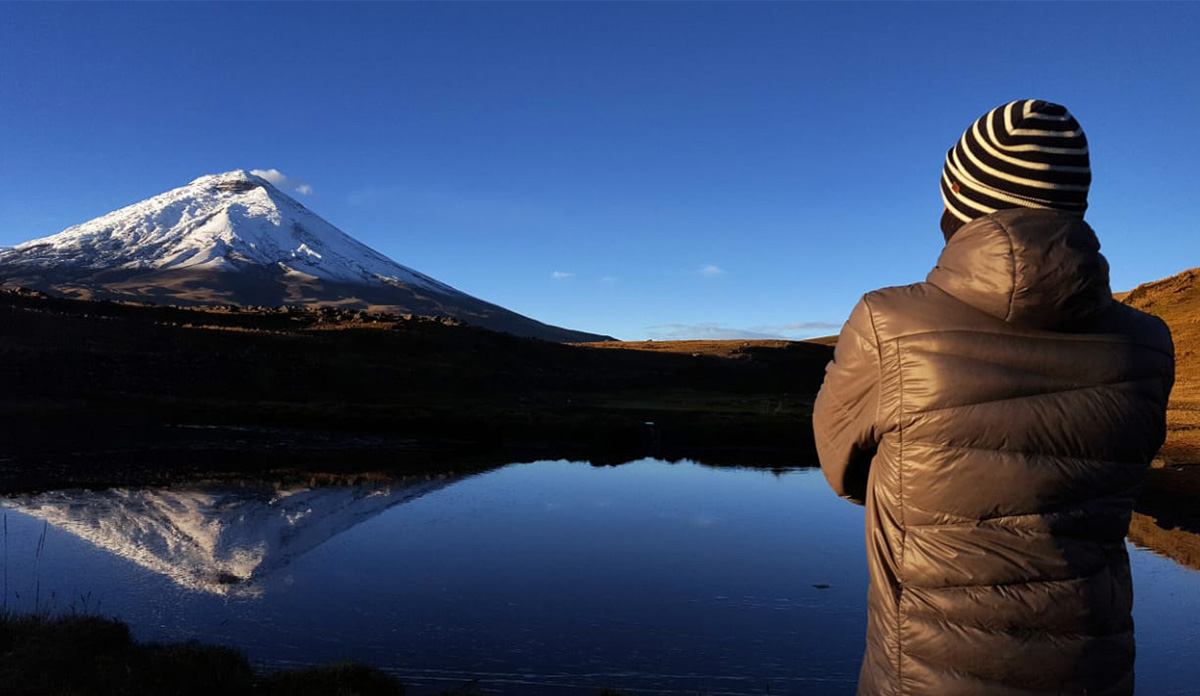Discover our four worlds!
From the imposing Andes, highlands carpeted with colorful fields, fascinating indigenous markets and communities to well-preserved colonial architecture cities home to a diverse mix of people. Then descend the slopes to immerse yourself in the Amazon rainforest as culturally and ethnically diverse as its wildlife. Have moments of relaxation or practice a variety of sports activities on the Pacific coast. Located just 600 miles off the Ecuadorian coast, the awe-inspiring Galápagos Archipelago needs no introduction. For a tailor-made trip to Ecuador, ITK Voyage is a specialist!
The Republic of Ecuador
Some facts about the country
Ecuador is one of the only countries in the world where the terms discovery, travel, and exploration still make sense. In fact, 4 regions of Ecuador with totally different biotopes make up the country from east to west: the Amazon, the Andes, the Pacific coast and the Galapagos Islands.
The Latin American Republic of Ecuador, whose capital is called Quito, is surrounded to the south by Peru and the north by Colombia.
Its name comes from its position on the “equatorial line”. Ecuador is a relatively small country since its area is only half that of France, for example. The official language is Spanish, spoken by 93% of the population, followed by Quechua (6%) then Shuar and other languages (1%).
The Ecuadorian population is made up of 60% mixed race, 30% indigenous, 7% white and 3% black. This ethnic diversity makes of Ecuador a unique and exciting mix of cultures and coexistence. It is therefore possible to discover different cultures across different regions within the same country, from the Amazon, to the Galapagos, from the Pacific coast to the Andes Valley.
Religions and various beliefs are very present in this small Andean country. 94% of Ecuador’s population is Catholic while 6% of them are Protestant.
Ecuador in the History
Ecuador, cradle of several civilizations. Whether on the coast, in the Andes or the Amazon. However, the pre-Hispanic period remains rather unclear. While some archaeological sites dating from 3,500 BC reveal fabulous treasures of the Valdivia, and some other cultures. Ecuador’s best-preserved archaeological site, Ingapirca, it testifies the cohabitation of the two cultures, Inca and Cañary.
Most of the past civilizations of Ecuador remain very mysterious, all we have are traces, tales and traditions, interesting archeologyc rests and customs, however, we have very little precise knowledge of Ecuador until the 16th century.
Ecuador & the Conquistators
In 1532 first Spanish Conquistadors arrived in Ecuador under the command of Francisco Pizzaro. The event was considered by the Incas as an omen of the end of the world, this belief caused the people to weaken morally in the face of the invader. In addition, the latter will arrive Ecuador along with many diseases back then unknown and which will kill the Indigenous people in masse.
After centuries of “Mestizaje”, it was not until the beginning of the 19th century that the first signs of protests appeared in Quito -Ecuador capital-. The first Ecuadorian insurrection will take place in 1809. It will then take 12 years of fierce fighting to allow General Antonio José de Sucre and Simón Bolívar to achieve the decisive May 24, 1822 victory on the Battle of Pichincha and thus obtain the surrender of the Spanish troops. The region then became part of the Gran Colombia Republic -founded and ruled by Bolívar- which included Ecuador, Venezuela, Panama and Colombia.
Economy
Over the past century several “booms” have been experienced in the Ecuadorian economy . First, with the “Cocoa Production” in the early 20th century, then the manufacture of Panama hats from 1944, bananas in the 1950s, oil in the 1970s and finally shrimp in 1990.
Unfortunately, Ecuador will experience a serious economic crisis in 1999, due, in particular, to a nearly 200% “Sucre” devaluation (the original currency “Sucre” was replaced by the US Dollar) and the bankruptcy of a large part of the Ecuadorian banking system.
Ecuador dollarization in 2000 will help to establish a “certain stability” of the Ecuadorian economy but will result in a decrease in its competitiveness and create dependence on the United States which represents 50% of its exports.
Climate in Ecuador
Wheather conditions differs depending on where you are in Ecuador (Regions). Temperatures can be high in the Amazon rainforest region, on the Ecuadorian Pacific coast and Galapagos, but they remain moderate in the Andes, thanks to the altitude.
Generally speaking, there are two main seasons in Ecuador: the dry and wet seasons. In the Ecuadorian Andes, the rainy season lasts from February to June, while it is present from January to May on the coast of Ecuador and in the Galapagos archipelago.
As for the dry season, it is present from June to January in the Andes and from June to December on the coast and the Galapagos. In the Ecuadorian Amazon, rain is present all year round with higher precipitation from April to June.
More about Ecuador at:










